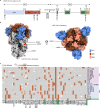Antibody escape and global spread of SARS-CoV-2 lineage A.27
- PMID: 35241661
- PMCID: PMC8894356
- DOI: 10.1038/s41467-022-28766-y
Antibody escape and global spread of SARS-CoV-2 lineage A.27
Abstract
In spring 2021, an increasing number of infections was observed caused by the hitherto rarely described SARS-CoV-2 variant A.27 in south-west Germany. From December 2020 to June 2021 this lineage has been detected in 31 countries. Phylogeographic analyses of A.27 sequences obtained from national and international databases reveal a global spread of this lineage through multiple introductions from its inferred origin in Western Africa. Variant A.27 is characterized by a mutational pattern in the spike gene that includes the L18F, L452R and N501Y spike amino acid substitutions found in various variants of concern but lacks the globally dominant D614G. Neutralization assays demonstrate an escape of A.27 from convalescent and vaccine-elicited antibody-mediated immunity. Moreover, the therapeutic monoclonal antibody Bamlanivimab and partially the REGN-COV2 cocktail fail to block infection by A.27. Our data emphasize the need for continued global monitoring of novel lineages because of the independent evolution of new escape mutations.
© 2022. The Author(s).
Conflict of interest statement
The authors declare no competing interests.
Figures






References
-
- Lan J, et al. Structure of the SARS-CoV-2 spike receptor-binding domain bound to the ACE2 receptor. Nature. 2020;581:215–220. - PubMed
Publication types
MeSH terms
Substances
Supplementary concepts
Grants and funding
- G0D5117N/Fonds Wetenschappelijk Onderzoek (Research Foundation Flanders)
- G098321N/Fonds Wetenschappelijk Onderzoek (Research Foundation Flanders)
- C14/18/094/Fonds Wetenschappelijk Onderzoek (Research Foundation Flanders)
- G0E1420N/Fonds Wetenschappelijk Onderzoek (Research Foundation Flanders)
- G098321N/Fonds Wetenschappelijk Onderzoek (Research Foundation Flanders)
LinkOut - more resources
Full Text Sources
Medical
Molecular Biology Databases
Miscellaneous

